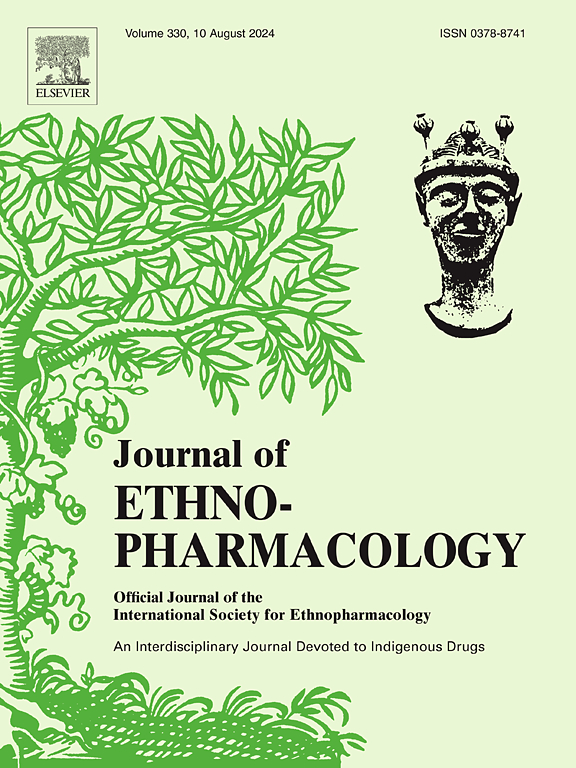Chemical diversity of the herbal decoction of Plectranthus ornatus and its anti-nociceptive and anti-inflammatory activities in zebrafish models
IF 4.8
2区 医学
Q1 CHEMISTRY, MEDICINAL
引用次数: 0
Abstract
Ethnopharmacological relevance
Plectranthus ornatus is a medicinal plant originally from Africa but adapted to Brazil's climate conditions. It is recognized for its therapeutic properties, particularly for treating liver and stomach diseases, gastritis control, heartburn, and hangover. Therefore, studies on its chemical composition and pharmacological evaluation are important for the safe use of the plant.
Aim of the study
To investigate the chemical composition and pharmacological activity of leaf decoction of P. ornatus.
Materials and methods
The lyophilized herbal decoction from P. ornatus leaves was extracted with MeOH (methodology A), and CHCl3 and n-BuOH (methodology B). The compounds were isolated using chromatographic techniques. Their structures were determined using spectroscopic methods (1H and 13C NMR, IR, and HRESIMS) and comparison with published data. The lyophilized herbal decoctions DPO A (decoction from methodology A) and DPO B (methodology B), and compounds 8, 9, 15, and 16 (4, 20, and 40 mg/kg) were evaluated for their toxicity, anti-nociceptive, and anti-inflammatory effects in experimental adult zebrafish (Danio rerio) models.
Results
The present study focused on the CHCl3 and MeOH soluble fractions from the lyophilized leaf decoction leading to the isolation of five new diterpenes (1, 4-7) and two new glucuronide flavonoid derivatives (2 and 3). In addition, four diterpenes (14–17), two glucuronide flavonoid derivatives (10 and 11), three phenolics (8, 12, and 13), and one disaccharide (9) previously reported were also isolated. In zebrafish essays, all samples showed no toxicity and exhibited an anti-nociceptive effect in at least one of the tested doses: 9, 15, 16, and DPO B (4 mg/kg), 8 (20 mg/kg), and DPO A (40 mg/kg). Moreover, the compounds 15 (4, 20, and 40 mg/kg) and 16 (4, 20, and 40 mg/kg) exhibited anti-inflammatory effects.
Conclusion
The lyophilized decoctions (DPO A and DPO B) including the compounds 8, 9, 15, and 16 exhibited significant anti-nociceptive effects in adult zebrafish and showed no toxicity. Since pain can be a symptom of liver, stomach, and gastrointestinal disorders, and all the samples proved to be non-toxic, the herbal decoction of P. ornatus leaf could be considered a potential therapeutic option in pain management, supporting the ethnopharmacological use of the plant.

斑马鱼模型中斑胸草汤剂的化学多样性及其抗伤害和抗炎活性。
民族药理学相关性:斑胸草是一种药用植物,原产于非洲,但适应巴西的气候条件。它是公认的治疗性质,特别是治疗肝脏和胃部疾病,胃炎控制,胃灼热和宿醉。因此,对其化学成分和药理评价的研究对其安全使用具有重要意义。目的:研究花楸叶煎液的化学成分和药理活性。材料与方法:采用MeOH(方法学A)、CHCl3和n-BuOH(方法学B)分别提取花椒叶中草药冻干汤剂,并采用色谱技术对化合物进行分离。通过光谱方法(1H和13C NMR, IR和HRESIMS)确定其结构,并与已发表的数据进行比较。以实验成年斑马鱼(Danio rerio)模型为实验对象,评价冻干中药煎剂DPO A(方法A煎制)和DPO B(方法B煎制)以及化合物8、9、15和16(4、20和40 mg/kg)的毒性、抗伤害和抗炎作用。结果:本研究主要从冻干叶煎液中分离得到5个新的二萜(1,4 -7)和2个新的葡糖苷类黄酮衍生物(2和3)。此外,还分离到4个二萜(14-17),2个葡糖苷类黄酮衍生物(10和11),3个酚类物质(8、12和13)和1个双糖(9)。在斑马鱼论文中,所有样本都没有毒性,并且在至少一种测试剂量中表现出抗伤害性作用:9、15、16和DPO B(4毫克/公斤)、8(20毫克/公斤)和DPO A(40毫克/公斤)。此外,化合物15(4、20和40 mg/kg)和16(4、20和40 mg/kg)具有抗炎作用。结论:含化合物8、9、15、16的DPO A、DPO B冻干煎剂对成年斑马鱼具有明显的抗伤害作用,且无毒性。由于疼痛可能是肝脏,胃和胃肠道疾病的症状,并且所有样品都被证明是无毒的,因此可以将蛇麻叶的草药煎剂视为疼痛管理的潜在治疗选择,支持该植物的民族药理学使用。
本文章由计算机程序翻译,如有差异,请以英文原文为准。
求助全文
约1分钟内获得全文
求助全文
来源期刊

Journal of ethnopharmacology
医学-全科医学与补充医学
CiteScore
10.30
自引率
5.60%
发文量
967
审稿时长
77 days
期刊介绍:
The Journal of Ethnopharmacology is dedicated to the exchange of information and understandings about people''s use of plants, fungi, animals, microorganisms and minerals and their biological and pharmacological effects based on the principles established through international conventions. Early people confronted with illness and disease, discovered a wealth of useful therapeutic agents in the plant and animal kingdoms. The empirical knowledge of these medicinal substances and their toxic potential was passed on by oral tradition and sometimes recorded in herbals and other texts on materia medica. Many valuable drugs of today (e.g., atropine, ephedrine, tubocurarine, digoxin, reserpine) came into use through the study of indigenous remedies. Chemists continue to use plant-derived drugs (e.g., morphine, taxol, physostigmine, quinidine, emetine) as prototypes in their attempts to develop more effective and less toxic medicinals.
 求助内容:
求助内容: 应助结果提醒方式:
应助结果提醒方式:


